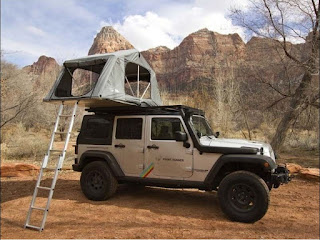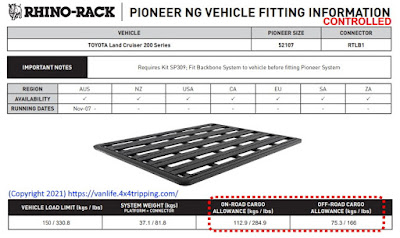- Get link
- X
- Other Apps
- Get link
- X
- Other Apps
Travelling with an RTT is not that uncommon anymore, but comes with a couple of disadvantages which are not that well known. We will start with those and will discuss further advantages or disadvantages later on in this article.
Often the weight of these roofracks together with a RTT exceed the weight limits that the car manufacturer allows for that roof. In addition, the weight limits as specified by the roofrack manufacturers typically differ between using them off- and on-road.
Let's analyze that a bit deeper with the help of an example. We will compare one of the strongest Toyota Land Cruiser 200, with a weight limit of 150kg (330lbs) for the roof, with a Ford Ranger UTE, which is commonly used for overlanding.
Some RTT and their weight
- 24kgs - Decathlon RTT (noname)
- 42kgs - GZ Aluminium Canopies ultra-lightweight carbon fiber clam shell
- 43kgs - Frontrunner soft shell
- 45kgs - Eezi-awn jazz and series 3 soft shells
- 48kgs - Thule Tepui Ayer 2 soft shell
- 66kgs - Magnolia Airlander
Some roof racks and their weight plus cargo load
- Rhino-Rack HD 3 crossbars 12kg rated for dynamic load 150 kg
- Frontrunner Slimline II 32kg and is rated for 300kg (what is missleading)
- Rhino-Rack Pioneer NG 37.1kg rated for dynamic load 150 kg
Weight limits for cargo loads are different depending on off- or onroad purpose. To get the exact values, I would recommend that you inquire with the particular manufacturer of the roof rack. Rhino rack is helping with a lot of the calculation work and publishing the detailed cargo load limits on their website for different car brands and models. What is the result?
Roofrack and RTT mounted on Vehicles
- Land Cruiser 200, 150kg roof load capacity, 112.9 kg on-road, 75.3kg offroad allowance
- Ford Ranger 75 kg roof load capacity, 50kg on-road, 33.5kg offroad allowance
You cant mount a RTT on most cars, if you like to drive offroad. With the Ford Ranger Ute you should not be doing serious offroading if you carry a roof top tent. You even have to choose one of the lightest roof top tents to be able to drive on the road legally.
How is this calculation done? Look into your car papers for the exact capacity of your roof. In the web these are not that easy to find, and depends often between exact model and year. Look for a manufacturer who shows the offroad capacity of their roof rack for your vehicle.
I did choose the Rhino Rack Pioneer Roof rack, and did get the valid values for the Ford Ranger Ute and the Land Cruiser 200. I did not even have to put in values or calculate myself.
Toyota Datasheet
Ford Ranger Datasheet
It is not that easy to get the correct values of the roof cargo allowance for different brands and models. In addition, roof-rack manufacturers make it hard to get distinct data for on road/offroad conditions. Both Datasheets of Rhinorack I was able to optain in a webshop: Land Cruiser 200 and Ford Ranger UTE
Here you find the Roof-Rack offroad weight capacity calculation for the Toyota Hilux, Suzuki Jimny, Land Cruiser 100 and the Nissan Nivara done by other bloggers. For most cars it doesn't look better than for the Ford Ranger Ute, if we look into it deeper.
At the german Buschtaxi Forum and the south african 4x4community you can read too about the issue.
If your vehicle is able to carry a RTT you have a good solution for getting a nap in nature. You have a good overview at the top of your car, and aren't in touch with the ground. Fewer non-flying insects, less wet if it rains and you even have some protection from other animals. That you easily can dismount it for daily life is another advantage compared to other solutions.
Disadvantages are that RTT are more exposed to noise and wind as compared to other travelling solutions, and that you will run into a "wet" issue after travelling extended during rainy days.
Articles you might also be interested in:
Comments





That a roofrack can break - is showed here: https://www.4x4community.co.za/forum/showthread.php/353687-Front-Runner-Roof-Rack-Failure
ReplyDelete